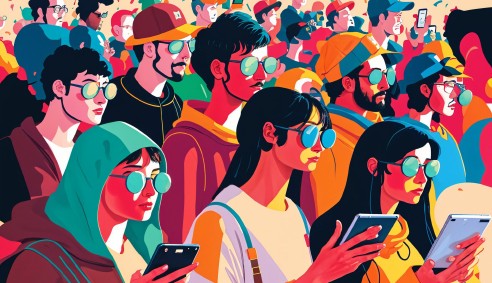From TikTok trends to Twitter threads, Gen Z is shaping not only the internet but also the very language we use to communicate. Their lingo, characterised by an ever-evolving lexicon of slang, abbreviations, emojis, and layered meanings, extends far beyond playful jargon. It reflects deeper social dynamics, generational identity, and cultural values. To the uninitiated, terms like ‘no cap,’ ‘rizz,’ ‘slay,’ or ‘it’s giving’ may sound confusing or even frivolous. Yet these expressions offer a window into how Gen Z interacts with the world, navigates identity, builds community, and resists old-fashioned norms.
Language has always been a site of generational distinction. Just as Baby Boomers had ‘groovy’ and Gen X had ‘whatever,’ Gen Z has developed its own verbal toolkit to set itself apart. But unlike prior generations, Gen Z’s language is shaped and spread with unprecedented speed thanks to the internet. Social media platforms like TikTok, Instagram, and X (formerly Twitter) act as accelerators for linguistic innovation. A single viral video can propel a new phrase into global usage within hours. This immediacy has led to a culture where fluency in Gen Z slang isn’t just a social bonus; it’s a badge of cultural literacy, particularly within online communities.
At its core, Gen Z lingo is a form of social signaling. Words like ‘sus’ (short for suspicious), originally popularised by the game Among Us, have taken on broader meanings in everyday conversations. Calling someone ‘sus’ can suggest dishonesty, awkwardness, or social inauthenticity, depending on the context.
What makes Gen Z slang particularly interesting is its fluidity. Words morph in meaning, tone, and usage as they travel across different subcultures. ‘Rizz,’ for example, began as a shorthand for charisma in romantic settings but has now evolved to describe someone’s overall charm or ability to navigate social situations. These shifts show how Gen Z wields language not just for efficiency but for nuance and creativity.
There is also a strong emphasis on irony and hyper-awareness in Gen Z communication. Much of their lingo thrives on layered meanings and double entendre. Phrases like ‘it’s giving…’ leave room for interpretation and often serve as a form of shorthand for deeper commentary. Saying ‘it’s giving the main character’ might be a compliment, but it also implies a level of self-awareness about one’s behavior being performative or curated. This ironic distance reflects a generation raised in the age of constant surveillance, both from institutions and through the ever-present lens of social media. Their language, then, becomes a tool for navigating visibility, constructing identity, and maintaining a balance between sincerity and performance.
Inclusivity also plays a central role in the evolution of Gen Z lingo. A significant portion of this slang has roots in African American Vernacular English (AAVE), LGBTQ+ communities, and other historically marginalised groups. Terms like ‘slay,’ ‘read,’ or ‘shade’ were once niche expressions within Black queer ball culture and drag communities, but have now entered the Gen Z mainstream.
Critics argue that this widespread adoption raises questions about cultural appropriation and linguistic ethics. While many Gen Z users celebrate the richness of these expressions, others are beginning to grapple with the importance of giving credit to the communities from which these words originate. The language itself becomes a battleground for issues of representation, privilege, and respect.
What sets Gen Z apart is their collective tendency to reflect on and critique their own language practices. Many young users are hyper-conscious of the origins and implications of their slang. Online discourse frequently includes discussions about whether using certain terms is problematic or whether language should be reclaimed or retired. This kind of meta-awareness suggests a level of linguistic maturity that goes beyond rebellion or trend-following; it shows a generation wrestling with the responsibilities of communication in a socially complex world.
Moreover, Gen Z’s lingo is deeply connected to mental health and emotional expression. In contrast to older generations, who may have stigmatised vulnerability, Gen Z often uses humor and slang to discuss serious issues in digestible, relatable ways. Phrases like ‘I’m literally deceased’ or ‘can’t even’ may seem exaggerated, but they often mask real feelings of anxiety, exhaustion, or existential dread. In this sense, their language functions as both a coping mechanism and a way to foster solidarity. When someone says ‘this is so real,’ they’re truth that resonates on a deeper level. These phrases may also be considered playful as a means to avoid an explicit expression of distress.
Of course, critics might argue that Gen Z’s reliance on slang undermines traditional grammar or clarity. However, language evolves to meet the needs of its users, and Gen Z’s lexicon is tailor-made for a digital world that values speed, wit, and connection.
Ultimately, Gen Z lingo is more than a collection of catchy words; it is a reflection of a generation that values authenticity, inclusivity, and adaptability. In a world defined by uncertainty and rapid change, their language serves as both a mirror and a megaphone. It tells us who they are, what they care about, and how they see the world. And as with any living language, what Gen Z says today will shape how we all speak tomorrow, no matter how hollow it may seem.
The writer is a cultural critic.



